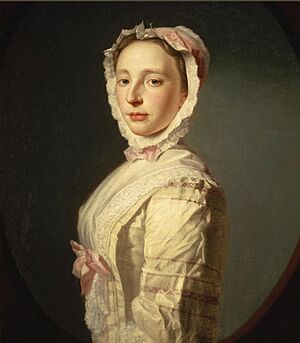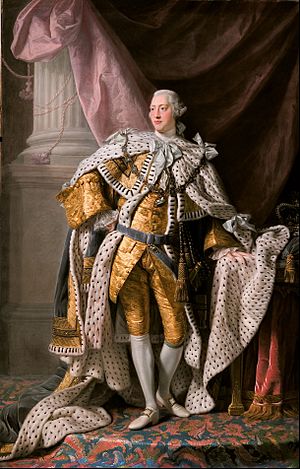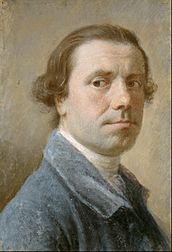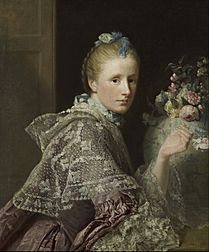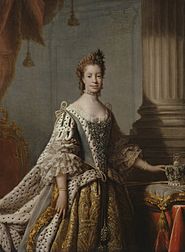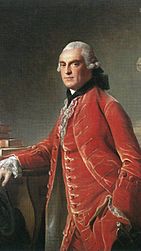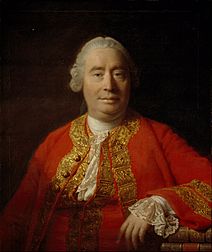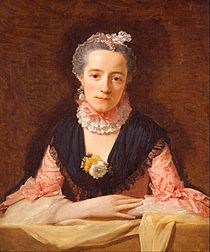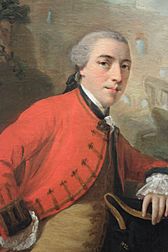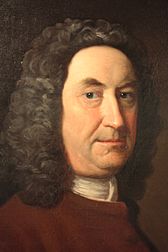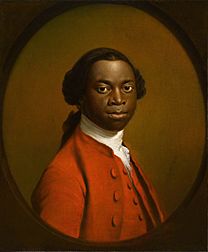Allan Ramsay (artist) facts for kids
Quick facts for kids
Allan Ramsay
|
|
|---|---|
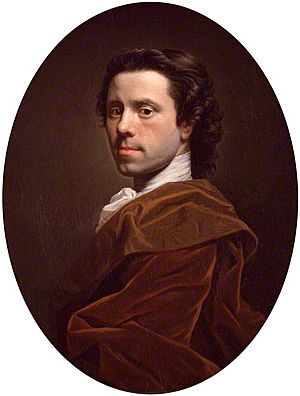
|
|
| Born | 13 October 1713 Edinburgh, Midlothian, Scotland
|
| Died | 10 August 1784 (aged 70) Dover, Kent, England
|
| Nationality | Scottish |
| Education | London (1733–36, under Hans Huyssing, and at the St. Martin's Lane Academy); Rome (1736–9, under Francesco Solimena and Francesco Fernandi). |
| Known for | Portraiture |
| Movement | Classicism |
| Patron(s) | Duncan Forbes, Duke of Bridgewater, George III |
Allan Ramsay (born October 13, 1713 – died August 10, 1784) was a very important Scottish artist. He was famous for painting portraits of people.
Contents
A Painter's Life and Work
Allan Ramsay was born in Edinburgh, Scotland. He was the oldest son of Allan Ramsay, who was a well-known poet.
When he was twenty, Allan Ramsay went to London to study art. He learned from a Swedish painter named Hans Hysing. Later, in 1736, he traveled to Rome and Naples in Italy. There, he spent three years learning from other famous artists like Francesco Solimena.
When he came back to Britain in 1738, he first lived in Edinburgh. He became known for his portraits, including one of Duncan Forbes of Culloden. He also painted a full-length portrait of the Duke of Argyll. This painting was later used on Royal Bank of Scotland banknotes!
Ramsay later moved to London. He was hired by important people, like the Duke of Bridgewater. People liked him not just for his art, but also because he was friendly and well-read. His main rival was another painter named Thomas Hudson.
In 1739, Allan Ramsay married his first wife, Anne Bayne. Sadly, Anne died in 1743, and none of their children lived to adulthood.
Later, he fell in love with one of his art students, Margaret Lindsay. She was the daughter of Sir Alexander Lindsay. They secretly married in 1752 in Edinburgh. Margaret's father was very upset that she married an artist and never forgave her. Ramsay promised to take good care of Margaret. They had a long and happy marriage, and three of their children, Amelia, Charlotte, and John, grew up.
From 1754 to 1757, Ramsay and Margaret traveled together in Italy. They visited places like Rome, Florence, and Naples. They studied old master paintings, ancient ruins, and archaeological sites. Ramsay also painted portraits of wealthy travelers who were on their "Grand Tour" of Europe.
After they returned, Ramsay became the Principal Painter in Ordinary to King George III in 1761. This was a very important job! The king asked him to paint so many royal portraits for ambassadors and governors that Ramsay needed many assistants. David Martin and Philip Reinagle were two of his most famous assistants.
Around 1770, Ramsay stopped painting to focus more on writing and studying. His health became poor after he accidentally hurt his right arm. His second wife, Margaret, died in 1782, which also affected him deeply. He finished one last portrait of the king and then traveled back to Italy. He left about 50 royal portraits for his assistant Reinagle to complete. Allan Ramsay died in Dover on August 10, 1784.
Allan Ramsay was good friends with the famous writer Samuel Johnson. Johnson once said about Ramsay, "I love Ramsay. You will not find a man in whose conversation there is more instruction, more information, and more elegance, than in Ramsay's."
Allan Ramsay's Art
Some of Ramsay's best early paintings include the full-length portrait of the Duke of Argyll. He also painted many portraits of Scottish gentlemen and ladies before he moved to London. These paintings show great skill and capture the unique personalities of the people. His drawings were excellent, and his skin tones in paintings were strong and clear.
His portrait of Lady Mary Coke is amazing because of how skillfully he painted her white satin dress. The portrait of his second wife, Margaret, which is in the National Gallery of Scotland, shows a lovely sweetness and tenderness. This painting also shows how French art influenced Ramsay's work, giving it an elegant and soft look.
In 2014, a TV show on the BBC suggested that Ramsay was the artist who painted the lost portrait of Charles Edward Stuart in 1745. This painting was made just before Stuart's invasion of England.
Where to See His Paintings

You can find Allan Ramsay's paintings in several British art museums. These include the National Gallery in London, the Derby Art Gallery, and the Glasgow Museum.
In 2016, a portrait of Richard Mead (who was King George II’s doctor) by Allan Ramsay was discovered. This happened during a BBC4 TV show called Britain's Lost Masterpieces. The painting was carefully repaired and cleaned.
One of Ramsay's most famous paintings is simply called "Portrait of an African." This painting has received a lot of attention because it shows an individual African person living in Britain in the 1700s. It's also interesting because we don't know who the person in the painting is. A museum in Exeter, the Royal Albert Memorial Museum & Art Gallery, made a documentary about this mysterious painting.
Queen Charlotte's Portraits
Some historians have discussed Allan Ramsay's paintings of Queen Charlotte. In 2009, a historian named Mario de Valdes y Cocom suggested that Ramsay's paintings of Queen Charlotte highlighted certain features. Some people believed these features came from a distant ancestor of the Queen, who was thought to be of Moorish (North African) descent.
Valdes suggested that copies of these paintings were sent to the American colonies. He thought they might have been used by people who supported ending slavery, as a way to show that people of different backgrounds could be important.
However, other historians disagree about whether the 13th-century ancestor was Black African. They also point out that this connection was many generations ago, so it might not be accurate to consider Queen Charlotte "Black" in a cultural sense, as her other ancestors were all European.
- Allan Ramsay's works
-
The lost portrait of Charles Edward Stuart, painted in Edinburgh in 1745
-
Queen Charlotte as painted by Allan Ramsay in 1762
-
Portrait of David Hume, 1754
-
John Burgoyne, painted in Rome in 1758
Writings
Allan Ramsay also wrote books and essays. Some of his works include:
- A Dialogue on Taste (1762)
- Letters on the Present Disturbances in Great Britain and her American Provinces (1777)
- Observations on the Riot Act (1781)
See also
 In Spanish: Allan Ramsay (pintor) para niños
In Spanish: Allan Ramsay (pintor) para niños


